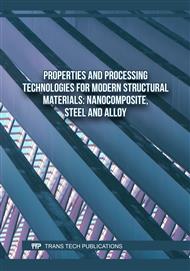[1]
T Albrektsson, P.I. Brånemark, Hans-Arne Hansson and Lindström JJ, Osseo integrated titanium implants. Requirements for ensuring a long-lasting, direct bone-to-implant anchorage in man.52(2) (1981) pp.155-170.
DOI: 10.3109/17453678108991776
Google Scholar
[2]
Osman, R.B. and M.V.J.M. Swain, A critical review of dental implant materials with an emphasis on titanium versus zirconia. Journal Materials (Basel), 2015. 8(3): pp.932-958.
DOI: 10.3390/ma8030932
Google Scholar
[3]
Bedi, R.S., et al., Biocompatibility of corrosion-resistant zeolite coatings for titanium alloy biomedical implants. Acta Biomaterialia, 2009. 5(8): pp.3265-3271.
DOI: 10.1016/j.actbio.2009.04.019
Google Scholar
[4]
L. Pawlowski; ״Thick Laser coatings: a review״; Journal of BiomaterialsVol.5, No.8, (1999) P. 279-295.
Google Scholar
[5]
Karin Eufinger; ״Effect of deposition conditions and doping on the structure, optical properties and photocatalytic activity of d.c. magnetron sputtered TiO2 thin films״; Ph.D. thesis University of Wetenschappen: Natuurkunde, (2007).
Google Scholar
[6]
MÜLLER E., DRAŠAR C., SCHILZ J., KAYSSER W.A., Functionally graded materials for sensor and energy applications, Materials Science and Engineering A: Structural Materials: Properties, Microstructure and Processing A362(1-2),(2003) p.17–39.
DOI: 10.1016/s0921-5093(03)00581-1
Google Scholar
[7]
Lu, L., Chekroun, M., Abraham, O., Maupin, V. and Villain, G., Mechanical properties estimation of functionally graded materials using surface waves recorded with a laser interferometer. NDT & E International, 44(2),( 2011) pp.169-177.
DOI: 10.1016/j.ndteint.2010.11.007
Google Scholar
[8]
Weikai Li and Baohong Han, Research and Application of Functionally Gradient Materials, Materials Science and Engineering, (2018).
Google Scholar
[9]
Radhi N.S., Preparation, Characterization, and Modeling Functionally Graded Materials in Bio-application. PhD thesis. University of Technology. Iraq, (2015).
Google Scholar
[10]
Craveiro, F., de Matos, J.M., Bártolo, H. and Bártolo, P., An innovation system for building manufacturing. In ASME 2012 11th Biennial Conference on Engineering Systems Design and Analysis (pp.175-179). American Society of Mechanical Engineers, 2012 July.
DOI: 10.1115/esda2012-82772
Google Scholar
[11]
Zhitomirsky, I. and L.J.J.o.M.S.M.i.M. Gal-Or, Electrophoretic Deposition of hydroxyapatite. Journal Mater Sci Mater Med. 8(4)( 1997) pp.213-219.
Google Scholar
[12]
V. Khalili, J. Khalil-Allafi and H. Maleki Ghalen; ״Titanium oxide coating on NiTi shape memory substrate using electrophoretic deposition process״; International Journal of Engineering Vol.26, Vol.7(2013) P.707-712.
DOI: 10.5829/idosi.ije.2013.26.07a.05
Google Scholar
[13]
Sorkhi, L., M. Farrokhi-Rad, and T.J.S. Shahrabi, Electrophoretic deposition of hydroxyapatite–chitosan–titania on stainless steel 316 L. 2(3)( 2019) pp.458-467.
DOI: 10.3390/surfaces2030034
Google Scholar
[14]
Mohamed Shatta, Magdy Badawy, and Diab Haddad, 'Surface Hardness Evaluation of A Thermoplastic Nylon Denture Base Material', Al-Azhar Journal of Dental Science, Vol. 23 (2020) pp.343-346-
DOI: 10.21608/ajdsm.2020.129721
Google Scholar
[15]
Kumar, R.R. and M.J.M.L. Wang, Functionally graded bioactive coatings of hydroxyapatite/titanium oxide composite system. Journal of Biomaterials Applications, 55(3) (2002) pp.133-137.
DOI: 10.1016/s0167-577x(01)00635-8
Google Scholar
[16]
A. Kocijan, M. Conradi and M. Hocevar, The influence of surface wettability and topography on the bioactivity of TiO2/Epoxy coatings on AISI 316L stainless steel, Materials, Vol. 12(2019) No. 11.
DOI: 10.3390/ma12111877
Google Scholar



